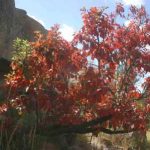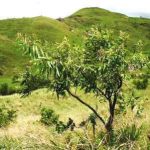TREE LIFE
March 2000
SUBS ARE DUE ON 1ST APRIL AND THE CURRENT UNHAPPY STATE OF AFFAIRS MAKES IT NECESSARY TO INCREASE THEM TO $120 PER ANNUM.
MASHONALAND CALENDAR
Tuesday 7 March. Botanic Garden Walk at 4.45 for 5 p.m. We will meet Tom in the car park. There will be a guard for the cars.
Sunday 19 March. Marussino Farm in the Trelawney area is the home of Sandy and Mike Potts and although we last visited them in November 1995 a return visit to this popular venue will be welcome. Plan to arrive at 9.30 with lunch for an all day outing.
Saturday 25 March. Mark’s walk will be at 2.30 p.m. at Arundel School. We hope to explore the area around the dam and any other areas of interest. On arrival at the School gates, the guard will direct Tree Society members to the place to park.
Tuesday 4 April. Botanic Garden Walk.
MATABELELAND CALENDAR
Sunday 5 March. Either to Umgusa or the Randall’s on the Victoria Falls Road to look at acacias. Meet at Girls’ College at 8 for a prompt departure at 8.30 a.m. Bring lunch and your chair, etc.
Sunday 2 April. Besna Kobila / Quaringa.
MAPOR ESTATES – ODZI SOUTH
Saturday 22nd January
The Mapor campsite is situated amongst magnificent huge granite domes, and I think it’s safe to say it would be impressive to most folk, even if not biased ‘Odzi-ites’. The rains have been good since New Year, the bush is thriving, and this, combined with a sunny day, made for a good outing. Our party was only 9 strong, and I have to say this was a real treat. A few days before, some of us were privileged enough to tag along with a SA Bot. Soc. party on a Bunga Forest outing. There were about 30 of us on a single file path. Scientific names don’t cope well on the broken telephone system that this necessitated – but the forest was great.
Mapor is in the middleveld – the altitude being ± 1000 m. We spent our first morning meandering around the boulders of a nearby kopjie, the novices scribbling furiously to record the knowledge so easily exuded by the ‘old hats’. From these scribblings I now write.
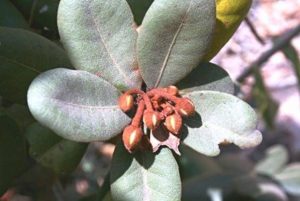
Vitellariopsis ferruginea. Photo: Mark Hyde. Source: Flora of Zimbabwe
Vitellariopsis ferruginea was an early and regular find. It has a somewhat restricted distribution to the upper Save region. The bushes were quite striking, with beautiful soft bronze new growth, clustered at the ends of branches. Green (apparently edible) fruit, similar to small unripe peaches, but covered in brownish hairs, were found on some plants. Not sure about the reference to a gourd in the common name of ‘Gourd Milkwood’ – the milk was there, but these fruit weren’t very much like ‘miniature gourds’ to me. The fruit is said to be single seeded, but having collected some, and recently peeled them, I found that the seed was quite deeply divided longitudinally and very easily fell into two separate halves.
Bridelia mollis and Friesodielsia obovata were regular and potentially confusing finds. Fortunately we met them both often enough to firmly commit to our cranial jellies the green leaf smell + stipules of Bridelia mollis, and the aromatic stipulelessness of ‘friesel diesel’.
The Mapor figs had us slightly foxed, but we decided one was definitely a knobbly fig – Ficus sansibarica – with projections on the branches and trunk, and spear shaped leaves clustered at the end of the branches. Ficus abutilifolia was less tricky, with large round pink veined leaves and pale grey snaking roots hugging a boulder. We encountered another fig on Orasi, and settled on Ficus stuhlmannii – a lowveld fig with patterned leaf undersides that look as if they have had lace stuck onto them.
A little (± 15cm) sensitive Oxalis sp. (Biophytum sp.) with tiny white flowers was put through its movements. I think we all had a touch. The leaves radiated out from the top of its stem – sort of like a helicopter blade, with the flowers sticking up above them – a Rasta style helicopter. There was some discussion as to exactly how a plant evolves this fascinating mode of defence. Is it particularly delicious, or is this just one of many possible solutions to avoid being munched?
We pondered too over an Acalypha sp. (?) with its monoecious flowering system. The final decision was, I think, that it was a more advanced method of flowering to separate the sexes like this. Margaritaria discoidea, common around Mapor, is another example, being dioecious – perhaps even one step up the evolutionary ladder if the sexes are on separate trees? And not only are the sexes separate, but the flowers are really no great shakes to look at – for humans anyway. The 3-balled fruit of Margaritaria discoidea harbour distinct metallic blue/green seeds – perhaps too small to be threaded for a necklace, but certainly worth a try!
Lagynias dryadum was common, displaying a few creamy scented flowers and its droopy, calyx crowned fruit. Other Rubiaceae members included Tricalysia niamniamensis and Rothmannia fischeri, with its armpit domatia forming distinct bumps along the midrib on the upper surface.
We found one tree that we ended up calling a sand papery Acokanthera. Some leaves were very coarse, whilst others were smooth and shiny. I believe it’s now been positively I.D-d as Acokanthera rotundata, so we’ll ignore the very restricted distribution maps on that one!
We brushed up against two species of the stinging nettle creeper – Tragia sp. (?). The one found on the slopes of Orasi mountain had a more upright character – we felt it first and found it later. It literally shone silver in the sun with stinging hairs. These are apparently used traditionally to cause sexual excitement. Not sure about the ‘sexual’ bit, but there was some excitement on contact – the Harare bunch chickened out of any further studies! Pity really. Obetia tenax – the tree nettle – was also found on Orasi, some leaves covered in larvae that are obviously nettle proof.
Hymenocardia acida’s golden gland dots on the leaf under surface were particularly pleasing through the magnifying lens, and the bright pinky-orange fruit of Ximenia caffra caused some serious face squeezing on tasting. I only found out afterwards that the seed inside is more palatable than the flesh, and heaps easier on the facial muscles.
Other finds included Ochna puberula – the granite Ochna, Dalbergia nitidula and Dalbergia melanoxylon. I recently rescued two fairly large stumps of Dalbergia melanoxylon from a neighbour’s cleared tobacco land. I’ve had them cut into stunning floor tiles, with the very dark plum heartwood surrounded by the pale yellow sapwood. Whilst showing one of these to a friend, learnt that Dalbergia melanoxylon has a CITES Appendix 1 listing! It is supposed to be as protected as the elephant, due to demand for the heartwood as black piano keys, small ornaments and woodwind musical instruments. The question is, of course, how do you enforce this protected state, especially if people don’t know about it?
To end – at last – I must just thank the Harare Tree Society folk for such a great weekend, and for sharing their knowledge so readily and repeatedly. We’ll be working out ways to get you all back here.
–Lynne Evans
MAPOR – DAY 2
Day two brought the party on to what appeared to be old tobacco lands and as the Odzi and Maranki districts are in a rain shadow influenced by the Vumba, the regeneration of the area is patchy and fairly slow. Most of the common colonisers are present being Dichrostachys cinerea, Terminalia sericea and Ziziphus mucronata while a number of annuals are present, one of the commonest being Ocimum sp. – wild Basil which has a pleasing odour as well as being used in traditional cultures as a meat flavouring.
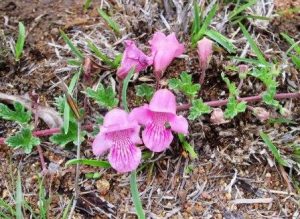
Dicerocaryum senecioides. Photo: Rob Burrett. Source: Flora of Zimbabwe
Another common annual is the stud thorn Dicerocaryum senecioides, the common name being derived from the hard pair of short spines on the seed capsule. The plant when immersed in water becomes very slimy and has found uses from a soap substitute to a lubricant for childbirth.
Along the base of Orasi, a huge chunk of granite which at 1530 meters broods over most of Mapor Estates, the woodland remains untouched and has wide variety of trees and shrubs. With the copious runoff from summer rainstorms, several damp cool overhangs occur providing a cool damp habit for Vitellariopsis ferruginea with the typically reddish brown appearance. And a large single specimen of Ficus stuhlmannii, the features of growth pattern and deep green colour of the foliage being most obvious to those perched above the toiling team below. From time to time, wafts of chatter from the excited Mutare(ites) / Odzi(ites) floated up to those of use perched above on a large flat rock – it is encouraging to note that the interest in Latin names is not dead!
Partly obscured by various of the Grewia sp., a shallow damp cave with patchy evidence of bushman paintings formed a useful breathing point, with a small Ficus natalensis hanging from a fault in the overhanging boulder having caught our attention. And in a damp place Mark also noted a single specimen of Fagaropsis angolensis with the typical gland dotted leaf margin. With time constraints only a few hardy souls ventured further up the increasing steep contours (later study of the 1:50000 map showed how steep it really is!) only to be stopped by a sheer wall of granite. To the right is a delightful untouched valley, entry to which is guarded by several large Tree Nettles – Obetia tenax. The smooth grey trunks and stiff looking leaves detract the eyes from the harsh spines that literally cover this large member of the URTICACEAE. Sue and Lynne having already experienced the effects of the normal nettle – Girardinia diversifolia, happily accepted that this one is a no-no! In this tiny wonderland with an enormous Paper Bark – Commiphora marlothii close to the entrance and a wall of sheer lichen covered granite wall beyond complete with a line of Sterculia quinqueloba, forms a superb natural garden.
Sadly there was not enough time to explore the area any further – possibly the Holmans might let us have another try. Another great day and thanks to Jenny and Frank for suggesting the area and I’m afraid the swimming pool and not the vegetation won my interest for the afternoon.
-A. MacNaughtan
DAY 3: 31st JANUARY 2000
With the number of Harare members dwindling, but boosted slightly by Sue Fawcett from Mutare and Jenny Holman from Mapor, we visited the Odzi River on our last full day. This is a rich site with rocky places, streams, ephemeral pools amongst the rocks and riverine vegetation. The altitude was 900 m, fairly low.
Near the river was a typical species of the SE lowveld, Breonadia salicina (Matumi). Small trees of Holarrhena pubescens (Jasmine tree) with its characteristic chunky bark were present in rocky places and some fine, large, examples of Diospyros mespiliformis (Ebony Diospyros).
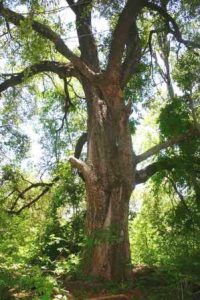
Diospyros mespiliformis. Photo: Bart Wursten. Source: Flora of Zimbabwe
A more unusual species seen was Ficus stuhlmannii (Lowveld fig). We had seen this the day before. This has a characteristic underside to its leaf with greyish net-veining. Its bark is also very dark-coloured and rough – not at all like the more typical smoothish, green or yellowish barks we more often see.
Common at Mapor is the somewhat local species, Lagynias dryadum. This occurs at low or medium altitudes in the eastern half of Zimbabwe. It belongs to the Rubiaceae and indeed has opposite leaves and interpetiolar stipules. Flowers were rare but a few were found and are greenish-yellow. The fruits are distinctive and hang down on pendulous pedicels.
Two herbs which were new to me were seen and later kindly identified by Bob Drummond. One is a blue-flowered Rubiaceae called Pentodon pentandrus. The other was Ethulia conyzoides. Both were along side streams which were running near to the river itself.
A very pretty herb seen was Tricliceras tanacetifolium. This is a relative of our common Tricliceras longepedunculatum, the Pimpernel, but this one has yellow flowers. Even more remarkable are the leaves which are deeply dissected (2-pinnatifid).
As usual, in wet habitats in Zimbabwe, there were a number of introduced species. A species of Blackjack, Bidens bipinnata, which seems to be everywhere in Zimbabwe now, was present in abundance. The introduced water fern, Azolla filiculoides, floated in streams and ponds.
After lunch we drove away from the river to a rocky hill known as Chiore. Of interest here was a large baobab right on top of the hill, which Jenny pointed out to us. We did not climb up to it but instead walked around the base of Chiore looking at the trees growing among the large boulders.
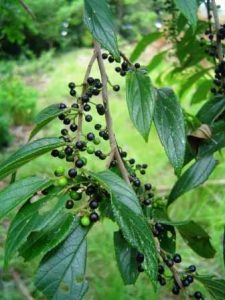
Trema orientalis. Photo: Bart Wursten. Source: Flora of Zimbabwe
Here, various new species came to light. Of interest was Trema orientalis (Pigeon wood), Tabernaemontana elegans (Toad tree) and a climber with small creamy-yellow flowers, Gymnema sylvestre.
During the weekend, we saw several times very poor material of a 3-foliolate Rutaceae – probably either a Teclea or Vepris. At the base of Chiore, we at last found good material and a decent pressed specimen was collected, although unfortunately there were no flowers or fruits; this plant is unidentified at the moment. Shortly after, we found a second species, possibly Teclea nobilis, although again this awaits identification.
On the drive back, through heavy rain at this stage, Jenny showed us a fine fruiting specimen of Hymenocardia acida (Heart fruit).
All in all, it was a memorable and botanically rich 3 days at Mapor. The rains held off until the third day – indeed the energy-sapping, rather moist, heat in the afternoons was more of a problem! There was much of interest and no doubt we will be back.
Our thanks go to the Holmans’ for their warm hospitality. It was also very nice to have the very enthusiastic people from Mutare join us – someone on every day.
-Mark Hyde
ODZI POSTSCRIPT: Acokanthera rotundata
NEW TO THE E DIVISION
On the first day at Odzi, we found a tree with milky juice and opposite leaves, some of which were exceptionally rough. Could this be Acokanthera rotundata, we wondered? An odd thing about it was that although some leaves were rough, others on the same tree were entirely smooth. The distribution map in Coates Palgrave also suggested the species was unlikely.
On return to Harare, I compared the specimen with those in the Herbarium. It was a very good match – the Herbarium specimens also showed the same feature of mixed rough and smooth leaves. Bob Drummond also confirmed the name.
As regards the distribution, although most of the specimens come from the Matopos (W division), it has been found sporadically in the Northern division (these specimens were not available and I therefore don’t know specifically where it has been found). And rarely in the Southern division (near Lake Mutirikwe and from Bikita District). Our Odzi material extends the range considerably and is a new record for the E Division.
-Mark Hyde
THE MUKAMBA ON THE HIGHVELD
There are two sorts of bean that are interesting to a wider circle than cooks and market gardeners. One is the mahogany bean, pitch black, with what looks like a crest of red sealing wax on the end of it. These beans are about the size of the top joint of one’s thumb, and grow six or eight in a pod – quite one of the most beautiful things you can see amongst many beautiful products of bush and tree.
J. PERCY FITZPATRICK (1892) – THROUGH MASHONALAND WITH PICK AND PEN
Every now and then a tree will turn up in the most unlikely place, and one is left wondering how and why – questions that are seldom answered satisfactorily. And yet it is remarkable how full of surprises Zimbabwe’s highveld can be – the mopane near Beatrice, the Marula and the sausage tree between Beatrice and Chivhu, the sandilboom trees near Headlands. These are all lowveld trees that shouldn’t be where they are, but there they stand for all the world to see.
One of these anomalies is the mukamba tree 58.4 kilometres out of Harare on the Bulawayo road, between Norton and Selous. The altitude is 1340 metres, which is considerably above its normal altitudinal limit of around 1000 metres. The mukamba, Afzelia quanzensis, is the well-known mahogany of the lowveld and its fringes, but there it is, an unexpected intruder on the highveld, somewhat battered by road-making equipment for it stands only a few metres off the edge of the tar on the north side of the road. In June 1987 it was 13.7 metres tall, with a diameter of 81.7 cm and a crown spread of 12 metres – not very impressive statistics, but if you consider the altitude it is remarkable that the tree should have been there at all.
Further down the road, near Chegutu, other speci¬mens of mukamba can be seen here and there as lone trees left standing in croplands, but this is in a lower and warmer region representing the general upper limits of the species. The tree near Kilometre 58 is at the extreme altitudinal limit of the species range, and periodically it may fall to produce its well-known pods with their black-and-red seeds.
The most famous mukamba tree in Zimbabwe is the one at Amandundumela in the Gwayi Forest area, immortalized by June Farquhar in her book The Mukamba Tree, which was published in 1974. This tree was 24 metres tall, with a bole diameter of 1.44 metres, in March 1987. And at Gwaai Ranch in the Chiredzi district there was another large specimen in July 1985, also 24 metres tall, but 1.12 metres in bole diameter. Gwaai Ranch has since become the Nyahombwe Resettlement Area, and the tree is located near the Dzapera dip, but there is so much felling of mukamba in that part of the country for huge woodcarvings of hippo that the long-term survival of this specimen is doubtful. It may have already gone by now.
-Lyn Mullin
BOTANIC GARDEN WALK: TUESDAY 8th FEBRUARY 2000
We were very pleased to see Tom again, back from an operation in South Africa and restored to health. Before we began the walk, Andy gave Tom a small gift to thank him for his continuing to lead us in the monthly walks for yet another year.
On the walk today Tom took us through what was probably the last part of the Euphorbiaceae.
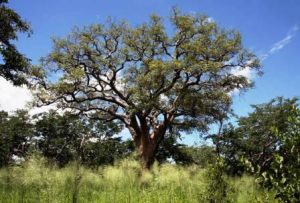
Schinziophyton rautanenii. Photo: Bart Wursten. Source: Flora of Zimbabwe
We first looked at Schinziophyton rautanenii (formerly Ricinodendron rautanenii), the Manketti tree, or in Ndebele, Mugongo. This is a beautiful species with its digitate, discolourous leaves, which are dark green above and pale beneath. The trunk is grey and smooth, appearing almost swollen and with faint transverse ridges. It is generally found on Kalahari sand, but Tom pointed out that it is not confined to this, but also sometimes occurs on cretaceous sands, for example in Mozambique.
A lens helped to reveal two interesting spot-characters. Meg Coates Palgrave pointed out two green dots, possibly glands, right in the centre of the leaf at the point from which the leaflets radiate.
A further useful character is that the lower side of the leaf is stellately hairy. Some other species in the family have this too and it can be a useful confirmatory character. For example, all the species of Croton do (and other species you might confuse with Croton do not, for example Macaranga mellifera or Alchornea laxiflora). Another species with numerous stellate hairs on the underside is Neoboutonia macrocalyx, seen not long ago on one of our E Districts trips.
Schinziophyton is, of course, very unusual in the family in having digitate leaves, although some, for example, Ricinus, the castor-oil plant do have leaves which are palmately lobed. No one was able to explain the origin of the English name – Manketti tree or Manketti nut. Can any reader make a suggestion?
In the forest section, we saw two interesting shrubs. One was Erythrococca polyandra, (Forest red-berry) a rain forest species. It has a rather larger leaf than the other two species of Erythrococca (Erythrococca menyhartii and Erythrococca trichogyne) and the leaves have a whitish margin. Tom mentioned that it occurs up to 2000 m in altitude and, in particular, at Chirinda Forest.
Another interesting species is Andrachne ovalis (Insecticide root). This is rare in Zimbabwe; Tom has only seen it at Cecil Kop in Mutare. Tom mentioned that in the Gardens, the plants only last 3-4 years but continue to seed themselves. The species is shrub-sized with glossy small leaves and was bearing the typical 3-lobed fruit of the Euphorbiaceae.
In forest understorey grows Alchornea hirtella, (Forest bead-string), the rain forest equivalent of the low-altitude Alchornea laxiflora (the Lowveld bead-string). This occurs, for example, on Mt Nyangani.
0n next to some spiny succulent Euphorbia. Euphorbia ingens (Candelabra tree) is probably the most common large succulent Euphorbia and occurs in a wide range of habitats and at a wide range of altitudes. The magnificent one in the Botanic Gardens had whorled branches and lacked completely the ‘holes’ where branches had fallen off, which were such features of the next two species.
Euphorbia cooperi (Lesser candelabra tree) with its more curving candelabra-like branches is well known and is widespread throughout Zimbabwe, although it is less common than Euphorbia ingens. It perhaps prefers somewhat lower attitudes than ingens. The branches are deciduous and after falling leave ‘holes’ in the trunk which are spirally or irregularly arranged around the trunk.
The next and somewhat similar species, Euphorbia confinalis, had similar curved branches, but the remaining leaves and the ‘holes’ where the former leaves were vertically above one another.
Euphorbia halipedicola is also a bit like Euphorbia cooperi in appearance but was yellowish- green and the stem ridges had distinct wavy margins. It is a rare species, confined to the Save valley.
Euphorbia persistentifolia has 4-angled, somewhat square stems and, as the name suggests, has more persistent leaves than is usual with the large succulent Euphorbia spp.; and this specimen did have a number of smallish leaves congregated near the apex of the branches. Tom mentioned that it occurs in the Zambezi Valley on Karoo sediments and on hills.
The evening ended with an interesting session, looking at some S African trees, which included Heywoodia lucens (Stink ebony), which occurs in Natal and in the Lebombo Mountains.
Finally, some exotic trees were seen, including Tectona grandis (Burma teak) and Pterocarpus indicus.
Once again, it was a great opportunity to learn more about Euphorbiaceae in Zimbabwe and our thanks as usual go to Tom.
-Mark Hyde
OBSERVING BEE BEHAVIOUR
I was pleased to have received some response to my article on bees in Tree Life. However, some respondents during their observations were unsure as to what the honeybees were actually collecting from the flowers. Closer observation of honeybee activity can reveal what they are up to. Honeybees collect three categories of substances from plants:
• nectar which they convert into honey and which is their source of energy;
• pollen, to which they add enzymes and mix with honey and use mainly as a source of proteins together with minerals, fats, trace elements etc. and, finally,
Nectar is collected from the plant nectaries, either floral or extra floral as the case may be. Sometimes honeydew from sap sucking insects is collected by honeybees and converted into honey, as is sap from wounds in plants such as sugarcane. Pollen is collected either deliberately or incidentally in the nectar gathering process. In the latter case it is sometimes deliberately discarded before the forager returns to the hive.
The various resins and waxes used as propolis are from many sources such as the sticky covering of unopened leaf or flower buds, or sap from wounds on the plants. Bees are selective in the collection of this material, preferring substances high in aromatic volatiles.
Honey bees are what are referred to as flower constant, that is the individual worker bee will remain constant, working one particular species for as long as it continues to provide the sought after nectar or pollen, and they do not haphazardly flit from one plant species to another.
Foraging honeybees collecting only nectar go directly to the nectaries and thrust their mouthparts into them and suck up the nectar. The pumping action of the abdomen as the bee takes in a load of nectar is easily discernible.
Pollen foragers are more active on the flowers, spending most of their time on the anthers, crawling over them and apparently even inducing dehiscence by biting them. Collected pollen is transferred to the pollen baskets (corbicula) on the hind legs and these pollen loads are easily seen. This pollen transfer is sometimes done in mid-air and pollen collectors can often be seen hovering in front of the flowers while this transfer takes place.
Watching honeybees foraging can be quite fascinating, especially pollen collectors which have different techniques for different flower species. For instance, in collecting pollen from Dichrostachys cinerea bees rapidly run round and round on the surface of the basal yellow flowers picking up the pollen on their body hairs, moving quickly from flower to flower and then resting to transfer pollen from their bodies to the corbicula on their hind legs. However, when collecting pollen from Peltophorum africanum, bees scramble over the anthers of the flower and then back off, hovering in front of the flower while transferring pollen in mid-air before they visit the next flower. Once the strategies for each flower are known, it can even be ascertained from a distance what the bees are up to. As bees often work flowers on the canopies of large trees, a pair of binoculars may be necessary to observe them.
Pollination is a fascinating subject and much study has gone into the process as far as plants of commercial interest are concerned, but even with these the whole picture has not yet been worked out in many cases. Strategies used by plants to ensure cross-pollination (even self-pollinated plants have mechanisms favouring cross-pollination) are quite incredible in many species. The ecological relationships with pollinating can be truly amazing. Charles Darwin in 1877 wrote a book, The Various Contrivances by which Orchids are Fertilized by Insects, which is an enthralling publication. He later, in 1889, wrote a further book entitled The Effects of Cross and Self Fertilization in the Vegetable Kingdom, where he proved conclusively and dramatically the importance of pollination in the perpetuation of vigour maintenance of plant species. Much of the work on plant pollination since his time is based upon the theories he promulgated. Little has been added to the knowledge of pollination requirements of some species since his work was published. An amazing man – an amazing subject.
-P. TAYLOR
RECRUITMENT DRIVE FOR NEW MEMBERS Attached to this Tree Life is an application form for membership. Please pass it on to a friend who may like to join the Tree Society and learn about our vegetation, which after all is so vital a part of other outdoor interests such as wild life, birds, insects, etc.
We need new members and ideas for increasing membership are welcome.
Our address is:
P 0 Box 2128, Harare.
ANDY MACNAUGHTAN CHAIRMAN


